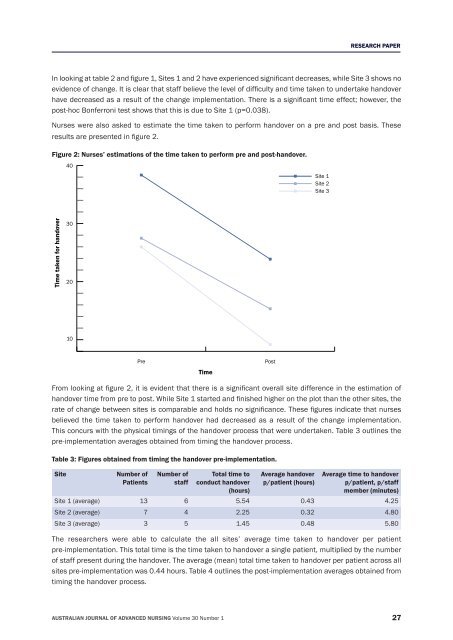Download Complete Issue - Australian Journal of Advanced Nursing
Download Complete Issue - Australian Journal of Advanced Nursing
Download Complete Issue - Australian Journal of Advanced Nursing
Create successful ePaper yourself
Turn your PDF publications into a flip-book with our unique Google optimized e-Paper software.
RESEARCH PAPER<br />
In looking at table 2 and figure 1, Sites 1 and 2 have experienced significant decreases, while Site 3 shows no<br />
evidence <strong>of</strong> change. It is clear that staff believe the level <strong>of</strong> difficulty and time taken to undertake handover<br />
have decreased as a result <strong>of</strong> the change implementation. There is a significant time effect; however, the<br />
post‐hoc Bonferroni test shows that this is due to Site 1 (p=0.038).<br />
Nurses were also asked to estimate the time taken to perform handover on a pre and post basis. These<br />
results are presented in figure 2.<br />
Figure 2: Nurses’ estimations <strong>of</strong> the time taken to perform pre and post‐handover.<br />
40<br />
Site 1<br />
Site 2<br />
Site 3<br />
Time taken for handover<br />
30<br />
20<br />
10<br />
Pre<br />
Time<br />
Post<br />
From looking at figure 2, it is evident that there is a significant overall site difference in the estimation <strong>of</strong><br />
handover time from pre to post. While Site 1 started and finished higher on the plot than the other sites, the<br />
rate <strong>of</strong> change between sites is comparable and holds no significance. These figures indicate that nurses<br />
believed the time taken to perform handover had decreased as a result <strong>of</strong> the change implementation.<br />
This concurs with the physical timings <strong>of</strong> the handover process that were undertaken. Table 3 outlines the<br />
pre‐implementation averages obtained from timing the handover process.<br />
Table 3: Figures obtained from timing the handover pre‐implementation.<br />
Site<br />
Number <strong>of</strong><br />
Patients<br />
Number <strong>of</strong><br />
staff<br />
Total time to<br />
conduct handover<br />
(hours)<br />
Average handover<br />
p/patient (hours)<br />
Average time to handover<br />
p/patient, p/staff<br />
member (minutes)<br />
Site 1 (average) 13 6 5.54 0.43 4.25<br />
Site 2 (average) 7 4 2.25 0.32 4.80<br />
Site 3 (average) 3 5 1.45 0.48 5.80<br />
The researchers were able to calculate the all sites’ average time taken to handover per patient<br />
pre‐implementation. This total time is the time taken to handover a single patient, multiplied by the number<br />
<strong>of</strong> staff present during the handover. The average (mean) total time taken to handover per patient across all<br />
sites pre‐implementation was 0.44 hours. Table 4 outlines the post‐implementation averages obtained from<br />
timing the handover process.<br />
AUSTRALIAN JOURNAL OF ADVANCED NURSING Volume 30 Number 1 27

















